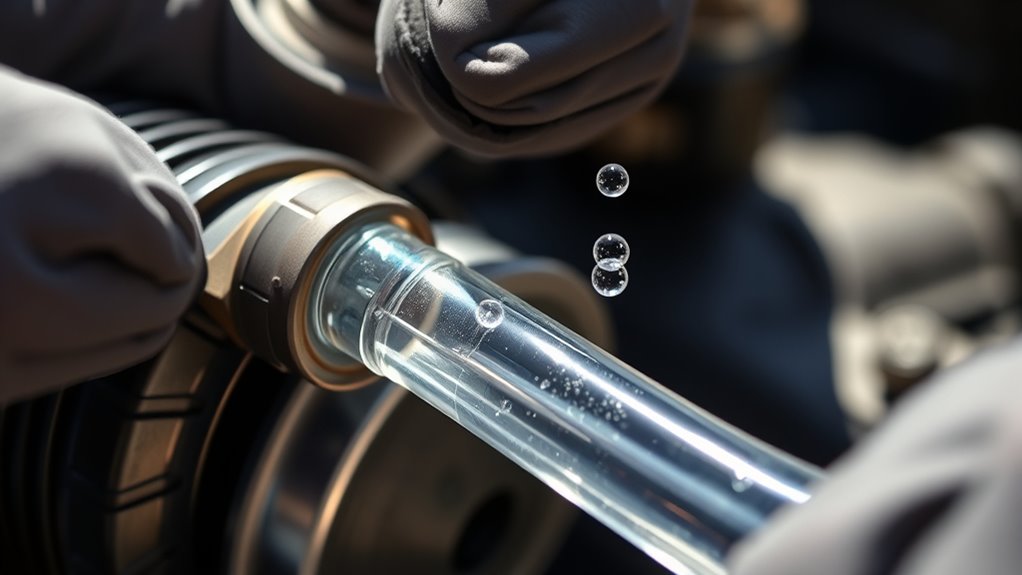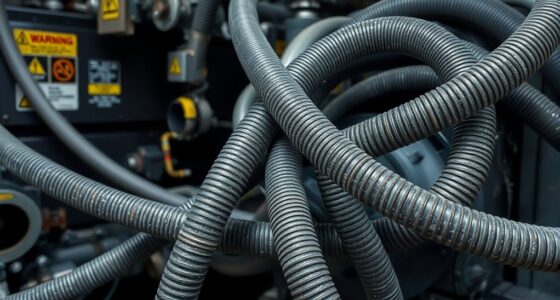To bleed air from your splitter’s hydraulic lines, first turn off the system and depressurize it safely. Locate the bleed screws or vents near high points of the system, attach a clear hose if available, and slowly open the screw to release trapped air. Watch for air bubbles and keep the fluid topped up. Once the flow is bubble-free, tighten the screw securely, and restart the system. Understanding these steps can help keep your splitter running smoothly.
Key Takeaways
- Turn off the splitter and depressurize the hydraulic system before bleeding.
- Locate bleed screws or vents near the cylinders or high points in the hydraulic lines.
- Attach a clear hose to the bleed screw, open it slowly, and watch for air bubbles.
- Continuously top off hydraulic fluid in the reservoir during bleeding to maintain proper levels.
- Close bleed screws securely, restart the system, and operate the splitter to verify smooth, air-free performance.

Have you ever experienced sluggish or inconsistent performance in your hydraulic system? If so, it’s likely that air has entered the hydraulic lines, causing disruptions in pressure and efficiency. Air in the system can lead to spongy controls, reduced power, and even equipment damage if left unaddressed. The good news is that with proper hydraulic maintenance and the right bleeding procedures, you can restore peak operation quickly and effectively. Understanding how to bleed a splitter or any hydraulic component is essential to maintaining system integrity and preventing costly repairs down the line.
Air in hydraulic systems causes sluggish performance—learn how proper bleeding restores peak operation efficiently.
To start, you need to identify the presence of air in your hydraulic lines. Signs include erratic movement of hydraulic cylinders, uneven or slow operation, and strange noises like bubbling or chattering. Once you’re sure air is the culprit, it’s time to follow specific bleeding procedures. Before doing anything, make sure the hydraulic system is turned off and depressurized to avoid any accidents. Safety is paramount during hydraulic maintenance, so wear protective gear and double-check that pressure has been safely released.
Next, locate the bleed screws or vents on your hydraulic splitter. These are typically positioned near the cylinders or at high points in the hydraulic lines where air tends to accumulate. Attach a clear hose or use a bleed kit if available, to direct expelled air and fluid into a container for proper disposal. Open the bleed screw slowly and watch for fluid to start escaping. If you see air bubbles, continue to allow fluid to flow out until it runs smoothly and consistently without bubbles. This process helps push trapped air out of the system.
During bleeding, keep an eye on the hydraulic fluid level in your reservoir. Air pockets can cause fluid levels to drop unexpectedly, so top off the fluid as needed with the recommended hydraulic oil. After bleeding, close the bleed screws securely and restart the hydraulic system. Gradually operate the splitter to check for smooth, responsive movement. If you still notice signs of air, repeat the bleeding process. Sometimes, it takes multiple passes to remove all trapped air, especially after maintenance or system leaks.
Regular hydraulic maintenance, including periodic bleeding, keeps your system running efficiently and prevents air from re-entering the lines. Remember, a well-maintained hydraulic system not only performs better but also extends the lifespan of your equipment. Mastering bleeding procedures ensures you can quickly resolve issues caused by air, minimizing downtime and maintaining consistent performance. Whether you’re working on a splitter or other hydraulic machinery, understanding these steps is vital to keeping your system in top shape. Proper system maintenance is key to avoiding issues related to trapped air and ensuring long-term operational reliability.
Frequently Asked Questions
How Often Should I Bleed the Hydraulic Lines?
You should bleed your hydraulic lines whenever you notice air bubbles, a spongy feel, or reduced performance. Regularly follow your equipment’s maintenance schedule to guarantee ideal hydraulic fluid quality, which helps prevent air buildup. Typically, bleeding might be needed every few months or after servicing. Keep an eye on hydraulic fluid levels and quality, and bleed the lines promptly to maintain efficiency and avoid costly repairs.
Can I Use Manual or Automatic Bleeding Methods?
You can use both manual and automatic bleeding methods for your hydraulic system maintenance. Manual methods involve opening bleed valves and using tools to release trapped air, while automatic systems employ built-in features to purge air efficiently. Both approaches help guarantee your hydraulic fluid stays free of air, maintaining system performance. Choose the method based on your equipment’s specifications and your comfort level with system maintenance tasks.
What Tools Are Necessary for Bleeding the Hydraulic System?
You’ll need a hydraulic fluid compatible with your system to prevent damage, along with a wrench or screwdriver to open bleed screws. A clear container helps catch expelled air and fluid. Wear safety precautions like gloves and eye protection to avoid injury from high-pressure fluid. Make certain the system is depressurized before starting, then carefully open the bleed screw, allowing trapped air to escape until fluid flows smoothly.
How Do Temperature Changes Affect Air in Hydraulic Lines?
Imagine a hydraulic splitter working in a cold environment; as temperatures rise, thermal expansion causes the hydraulic fluid to expand, leading to pressure fluctuations. These changes can trap air in the lines, making bleeding more difficult. Temperature shifts increase air entrapment by altering fluid density and pressure, so you need to monitor system temperature and bleed air promptly to maintain ideal operation and prevent issues caused by trapped air.
Is There a Difference in Bleeding Procedures for Different Splitter Models?
Yes, bleeding procedures can differ between splitter models. You should consult your splitter’s manual during maintenance to guarantee you’re following the correct process. Different models may have specific bleed valves or steps, especially depending on the hydraulic fluid types used. Always use the recommended hydraulic fluid and follow manufacturer instructions closely to prevent air pockets and maintain ideal performance. Proper bleeding extends your splitter’s lifespan and ensures safe operation.
Conclusion
Now that you know how to bleed the air from your hydraulic lines, you’ll keep your splitter running smoothly. Think of it like tuning a guitar—you need each string perfectly in tune for the best sound. Similarly, removing air guarantees your splitter operates efficiently and safely. Don’t let air pockets steal your power or cause damage. With a little patience, you’ll have your hydraulic system humming like a well-oiled machine in no time.








